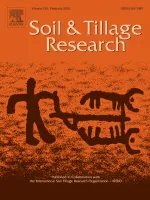Stability of humic acid carbon under conservation agriculture practices

Abstract
Recently conservation agriculture (CA) using the principles of zero tillage, crop residue management and suitable crop rotation has gained the momentum and quite popular among the farmers. Researchers throughout the globe have shown the potential of CA in enriching soil organic carbon storage in various soil types and cropping systems. But there is very limited study on the effect of CA on soil humic acid content and their stability and abundance of functional groups. An experiment was conducted in an Alfisols with four scenarios (designated as Sc) namely conventional farmers practice (Sc1) of transplanted rice (TPR) followed by conventional tilled broadcasted wheat (CT- wheat) with residue removal, transplanted rice (TPR) followed by zero tillage (ZT) wheat and mung bean with partial residue retention (Sc2), direct seeded rice (DSR) followed by ZT- wheat and mung bean with full residue retention (Sc3), ZT-maize followed by ZT-wheat and mung bean (Sc4) at the research farm of ICAR-Central Soil Salinity Research Institute, Karnal, Haryana, India. The objectives of this study were to assess the humic acid (HA) content and stability of soil carbon through desorption study and to characterize the functional groups of HA by Fourier Transform Infrared (FTIR) spectroscopy under different scenarios. HA was extracted from soil samples collected from 0 to 15 and 15–30 cm depth after rice harvesting in 2018 after nine years of the experiment. Results showed that Sc4 recorded significantly highest HA content at 0–15 depth (4.23 g/kg) and 15–30 cm soil depth (2.08 g/kg). Lower E4/E6 ratio revealed higher stability and humification of humic acid carbon under CA based scenarios. Lowest desorption rate constant (0.20/day) was observed under Sc4 indicating higher organic carbon stability in soil. Higher labile carbon and nitrogen was observed in soils under Sc3 as revealed through desorption study. FTIR spectroscopy results confirmed the prevalence of higher number of functional groups (Odouble bondCdouble bondO, Cdouble bondO or CHO) in HA under CA based scenarios with an order of Sc4 >Sc3 >Sc2 >Sc1. Therefore, CA is not only efficient in enriching the organic carbon in soil but also in more stable complex of HA with soil particles having long term implications in soil carbon sequestration for future posterity.
